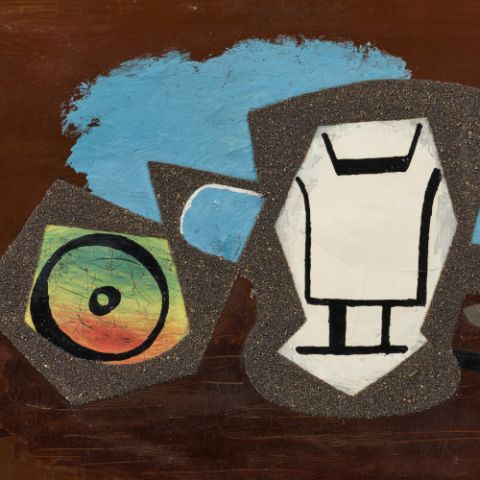
Lot 39 | Günter Fruhtrunk | Rote Randzonen I
Munich 1923 - 1982
Title: Rote Randzonen I.
Date: 1965.
Technique: Acryl und Kasein on canvas.
Measurement: 89,5 x 84cm.
Notation: Signed, inscribed and monogrammed verso lower right: FRUHTRUNK PARIS (underlined) ftk. Additionally inscribed and equipped with directional arrows verso and illegibly inscribed verso lower left.
Frame/Pedestal: Framed.
According to new research, the sizes in the catalogue raisonné are not correct. We are grateful to Walter Storms Galerie, Munich, for the kind scientific support.
Provenance:
- Galerie Denise René, Paris (label)
- Galerie Hans Mayer, Düsseldorf (label)
- Private collection New York
Exhibitions:
- Städtische Galerie im Lenbachhaus, Munich (label)
- Kunstmuseum Bonn, 2024
- Museum Wiesbaden, 2024
Literature:
- Günter Fruhtrunk Gesellschaft e.V.: Günter Fruhtrunk - Werkverzeichnis der Bilder 1952-1982, vol. 1, Berlin 2018, cat. rais. no. 477, ill.
- Exhib. cat. Pictures 1952-1972, Städtische Galerie im Lenbachhaus/Badischer Kunstverein, Munich 1973, cat. no. 47
- Exhib. cat. Günter Fruhtrunk, Retrospective 1952-1982, Kunstmuseum Bonn/Museum Wiesbaden, Cologne 2024, p. 68, ill. (here with frame measurements).
- Early work from the most important period of creation in the 1960s
- Exciting color space modulation in black and white, but also red, violet and two different shades of blue
- The Kunstmuseum Bonn and the Museum Wiesbaden honored the artist this year on the occasion of his 100th birthday with a retrospective in which this work was also shown.
Precise dynamics
The works of Munich artist Günter Frühtrunk are characterized by meticulous, mathematical precision and a unique sense of color. In his paintings, he combines dynamics with structure, color with non-color, and visualizes feeling through clarity in various serial variations.“Rote Randzonen I” is characteristic of Fruhtrunck's paintings, which he constructs as a black-and-white grid using a highly precise painting technique.With the help of delicate nuances of blue tones, which he occasionally uses instead of white, and narrow red and dark blue lines along the broader black strands, he creates space and shadow and lends the clear and consistent black a dynamism that appears to the viewer like a rapture of perception, a flaw in the clear grid system.The work, which at first glance appears to be strictly black and white, appears almost flickering, and is guided diagonally through the pictorial space in a trend-setting way. The work, which is strongly reminiscent of the principles of constructive art, unfolds in the contemplative context and in the perceptual process of the viewer as an emotionally charged, continuously developing and dynamic system. A rousing stream that seems to extend diagonally beyond the edge of the picture.
Rote Randzonen I - Variation and Rhythm
“Rote Randzonen I” from 1965 is considered a great example of Fruhtrunks creative phase from the late 1950s, in which he devoted himself to the repetition and rhythmization of his works.The fact that the work was included in the important retrospective of Fruhtrunk's work at the Museums Wiesbaden and the Kunstmuseum Bonn this year also underlines its historical significance. In the serially produced pictures, of which “Rote Randzonen I” is one, Fruhtrunk repeatedly takes up motifs and compositions, reconstructing and rearranging them.In relation to our present-day digital age, the works from this phase are thus extraordinarily topical, a quality that is further heightened by the reduction of color and form. Fruhtrunk renounced gestural expressionism early on and avoided the poetic weightiness of his contemporaries' images. Despite the indisputable parallels, he cannot be assigned to the art of constructivism either, due to his differentiated use of color and the dynamics of his works. In general, Fruhtrunks oeuvre still defies categorization today and stands as an independent, autonomous result of a deep examination of form, color, space and time. Likewise, his works are always based on an architectural approach.Not only because Fruhtrunk studied architecture as well as painting and was often involved in the design of house facades and interiors, but also because of the cubic forms and the materials such as gravel and sand that he often mixed into the paint of his works. Influenced by the trauma that later also led him to choose death, the works appear as an anchor point, a clear structure in contrast to his troubled mind.The resolution of circling, elusive thoughts into a strong, flowing stream. (Cf. exhib. cat. Günter Fruhtrunk - Retrospective 1952-1982, Kunstmuseum Bonn / Museum Wiesbaden, Cologne 2023)
Print this lot | Recommend lot |
Conditions of this Lot
32% buyer’s premium on the hammer price
Estimated shipping costs for this lot:
Arrangement after the auction.
Günter Fruhtrunk Germany Concrete Art Post-War Art Post War 1960s Framed Shapes Painting Acrylic Geometric Abstraction






